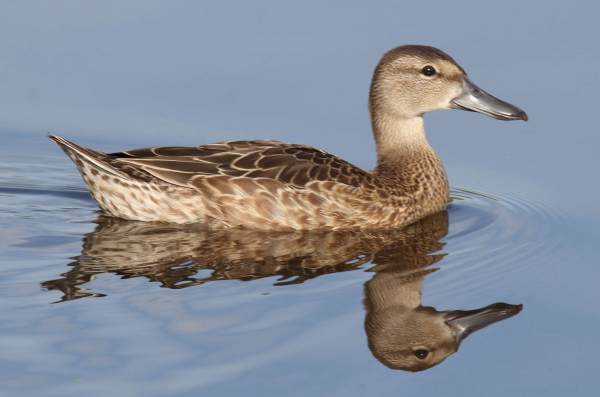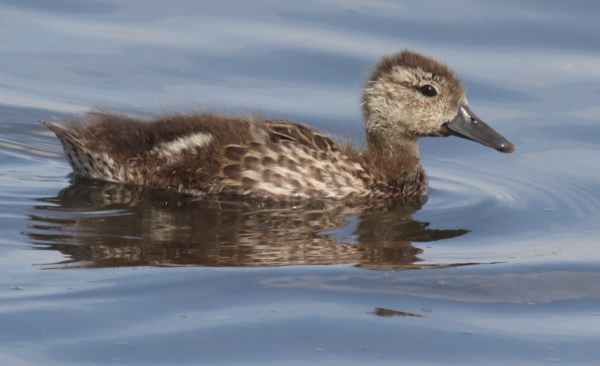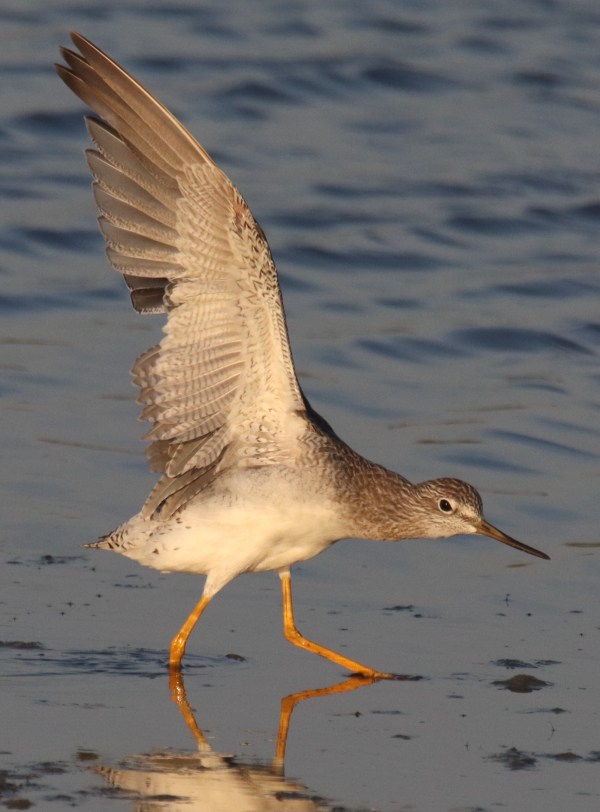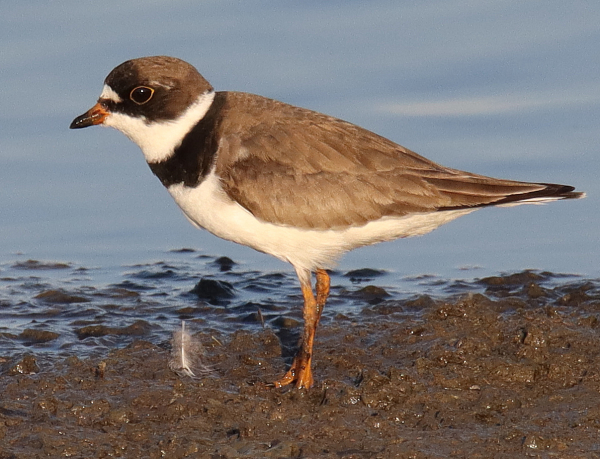
Likely a drake Blue-winged Teal in eclipse plumage, the simple colors of its plumage are accented by color reflected by the beautiful calm water. During August, many ducks have molted into their eclipse plumage.

A young Green-winged Teal duckling is molting its down in exchange for its first feathers.

Illuminated by the evening sun, a Lesser Yellowlegs flares its wings high among a variety of shorebirds that frequent Charo Marsh.

This Semipalmated Plover, in a photograph that is representative of a field guide image, was among the first of its species to migrate south from its Arctic nesting territory to the shore of a prairie wetland.
|
This was a “bird of the year” sighting! Not every rare bird makes it to the Rare Birds list, but personally, when we see a new bird in the field, in our yard, in our neighborhood, it’s always a thrill. A new bird sighting is never expected and always a fun surprise. Last Tuesday, after sending The Birding Wire off for publishing, it was later than usual for me to take a drive, but I wanted to see what shorebirds were on hand at Charo Marsh, thinking there might be a Semipalmated Plover among the variety of “sandpipers” that was close enough to photograph. Indeed, 2 plovers provided my first chance to photograph the species this season, but the real surprise was a distant look at what? A Black-necked Stilt!
I’ve only seen a couple Black-necked Stilts in the state of North Dakota, one 90 miles west-northwest of my office a couple years ago, and one 60 miles east-southeast a couple months ago – so this was a very rare sighting for me. An added point of interest was revealed by a documentary photo I took of the bird that showed this Black-necked Stilt was a recent fledgling! Where was this young bird raised?
I’ve been around Black-necked Stilts a lot in southern California, along the Gulf Coast, and on the edge of the Great Salt Lake, but they now appear to be a new bird moving into my current home state. Will Black-necked Stilts colonize this region and state the way that some other birds have during my lifetime? Already, other “southern birds” that have immigrated here include White-faced Ibis, Snowy Egrets, Great Egrets, Black-crowned Night Herons, Hooded Mergansers, and House Finches. I tried to re-find the Black-necked Stilt throughout the week without luck, but I’m staying aware in case I get another look and can add to its life story.
Local duck broods continue to mature, and it’s interesting to observe feeding or resting broods of well-feathered pintails, shovelers, teal, and Mallards at Charo Marsh and other duckling nursery wetlands. Through Sunday I only observed 1 new brood in my area – a new brood of 6 tiny Ruddy Ducks; however, I did see 2 new Mallard broods at Dogtown Marsh east of Bismarck last Wednesday. Also at Dogtown, I reconnected with the elegant Canvasback female with the multi-species brood that includes 3 now-feathered Canvasback ducklings and 6 Redhead ducklings. (This is the female Canvasback and her ducklings that were described and illustrated in one of last week’s Bird Photography features.)
Only a couple miles east-southeast of home, I also found a female Canvasback with 1 feathered Canvasback duckling and 1 large downy Redhead duckling. This was the first Canvasback brood I’ve seen in the area this season, but it is especially unusual considering the apparent discrepancy in age between the 2 ducklings. During the same birding drive, I observed a pair of Red-headed Woodpeckers at an annual nesting territory, and as I stopped to monitor the woodpeckers a few moments I noticed 3 Common Nighthawks flying nearby in the background of the view. Along the way I also observed a male Northern Flicker, and a male American Kestrel along the Lost Road, plus 2 other kestrels that I’d bet were older fledglings hanging out together in a local kestrel nesting area.
My great friend and cousin Dwight visited from Portland, Oregon last week, and he always likes to join me for a couple birding escapades during each visit, so after a pouring day of rain Saturday, we scouted the area Sunday to see what the countryside looked like. I was especially interested in checking on any changes among the shorebird species composition at Charo Marsh, but while Greater Yellowlegs and Lesser Yellowlegs seemed to have doubled in numbers, the only other shorebirds on hand were a Pectoral Sandpiper and a Least Sandpiper. Even the Killdeer seemed to be present in half the numbers.
We continued our drive, seeing an older brood of American Wigeons, 3 Swainson’s Hawks scattered along our route, and a resting group of White Pelicans. Dwight was most intrigued by an assemblage of ducks (mostly Mallards), Giant Canada Geese, and Franklin’s Gulls loafing on an open area on the edge of a shallow bay attached to a big lake. The ducks, geese, and gulls were in various stages of molting, with the ducks in full eclipse plumage and many likely unable to fly. Some geese may have been flightless too, having molted all the flight feathers in their wings simultaneously, which is the norm for ducks, geese, and swans after nesting.
Oriole Update
It’s official, the white-winged partial-albino male oriole is a regular visitor to my grape jelly feeder again – going on 12 days now! Its molt looks to be complete except for tail feathers that are still growing to full length, and a new tail feather even appeared on one side of the existing feathers last week. There is also another beauty of a male Baltimore Oriole that I have been seeing daily, including a 3-visit day last Thursday. It looks like my last regular Orchard Oriole moved on last week; but about the same time I recognized she wasn’t around, an older, slightly larger, slightly more olive-colored female Orchard Oriole began feeding at my jelly feeder at least once a day.
A Monday afternoon drive produced a couple surprise birds, most notably an adult Great Horned Owl on the wide open prairie devoid of trees, and a yearling Swainson’s Hawk swallowing a long garter snake it had apparently caught. As the wind calmed, new duck broods appeared including a Blue-winged Teal brood; but the other surprise was that after weeks of seeming inactivity at nearby Melody’s Marsh, I viewed a new Ruddy Duck brood, along with a new Gadwall brood, a Northern Shoveler brood, and another Blue-winged Teal brood. I hope you enjoy some interesting birding surprises throughout the month of August, at home and in the field.
Article and photos by Paul Konrad
Share your bird sightings and photographs at editorstbw2@gmail.com